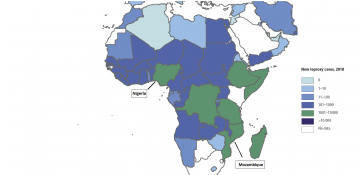Target countries
This project will be executed in two countries in Sub-Sahara Africa: Mozambique and Nigeria. These countries are two of the most endemic countries in Africa and are part of the WHO priority countries in the combat against leprosy. NLR has a longstanding presence in both countries.

In Nigeria, NLR initially operated through a local office that became the independently operating organisation ‘Leprosy and TB Relief’ (LTR) in 2018. In Mozambique NLR operates a country office in the capital of Maputo, with satellite offices in Nampula and Zambezia. With over 40 years of experience in each of the countries, NLR is well placed to execute a project like this, having the right connections, relations, and knowledge to ensure success.
According to the WHO 2018 leprosy update, Mozambique and Nigeria had 2,422 and 2,095 newly detected leprosy patients respectively, thereby accounting for over twenty percent of the total new leprosy patients in Africa.


Even though Mozambique and Nigeria represent vastly different geographical areas, as well as significantly different cultures and contexts, they have some commonalities. The first common denominator is that leprosy has officially been eliminated as a public health problem on the national level (definition 1 patient on treatment per 10,000 inhabitants). The consequence of this is that in both countries, leprosy is not necessarily seen as a priority anymore while it still presents a significant problem at sub-national levels.
In Mozambique, leprosy was declared to no longer be a public health problem in 2008 but this political declaration was not followed by measures that safeguarded full treatment of new patients and prevention of new infections. Instead, the government reduced the allocation of resources for leprosy. The result is that the number of new patients is rising. In Nigeria, the focus of both the government and the international community switched to diseases like tuberculosis, taking funding and political interest away from leprosy, causing a stall in its detection and treatment.
The second common denominator is that the percentages in newly detected children with leprosy is relatively high for both countries: 11% for Mozambique and 7.5% for Nigeria. This is a clear and worrying sign that transmission is still ongoing and that a new generation is already suffering from the devastating consequences of leprosy.
The third common denominator is that in both Mozambique and Nigeria, the percentage of newly detected patients with visible deformities stands at around 15%, which is very high, especially when compared to other high-endemic countries such as India (4%). These high percentages indicate a delay in case detection and these delays mean that it is likely that there are still many more undetected cases out there.